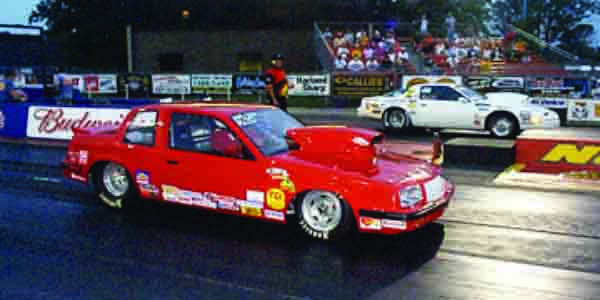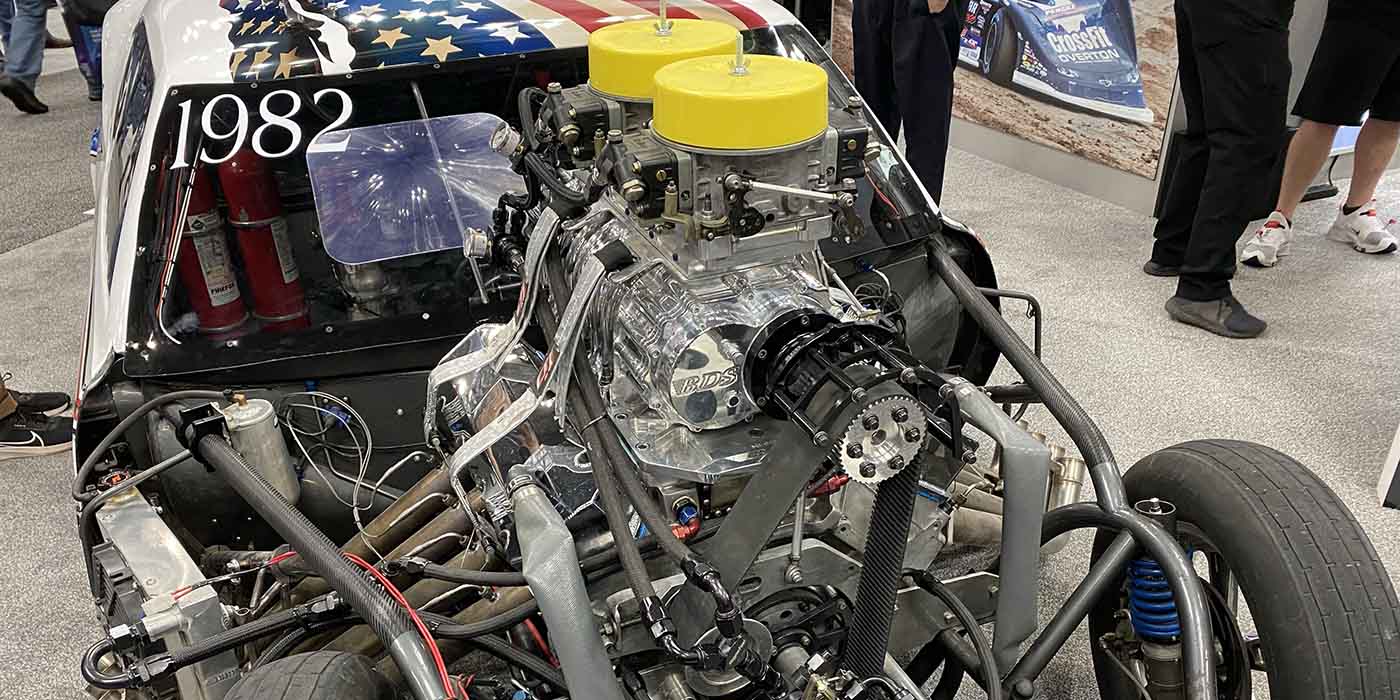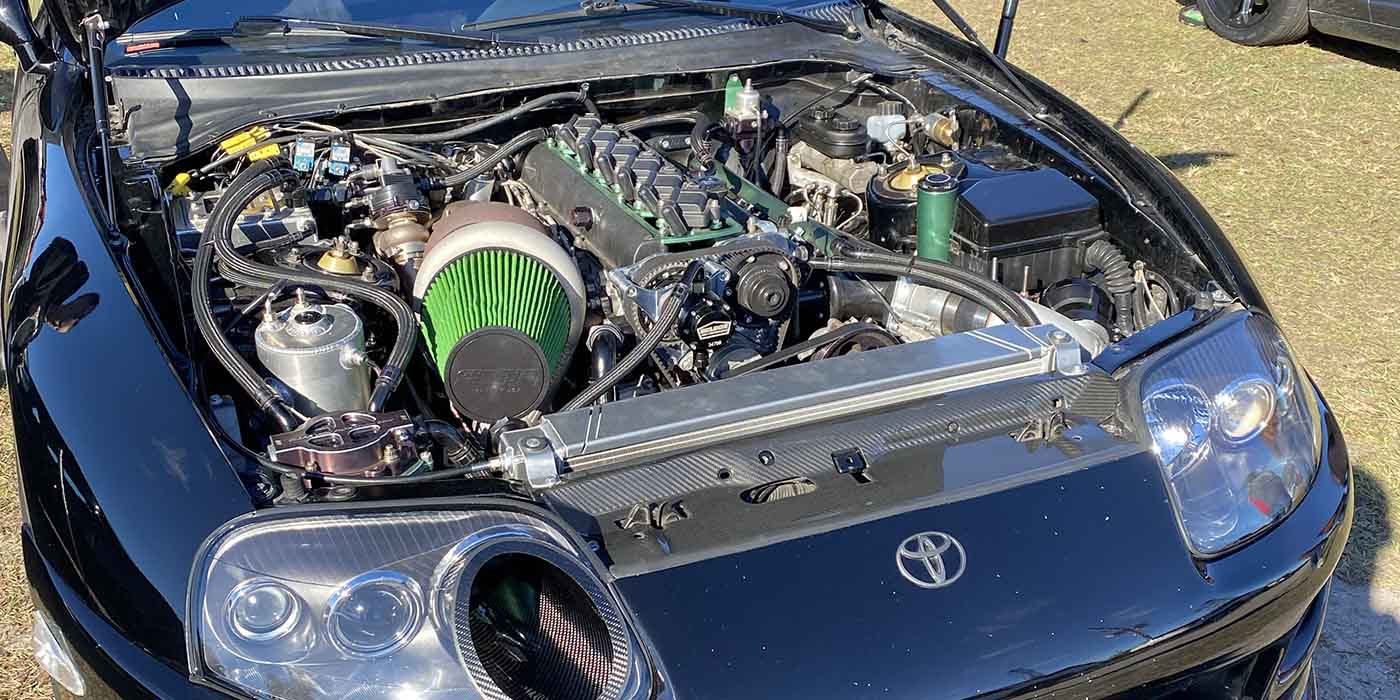Bracket racing is the most popular form of drag racing. Participants in various bracket racing classes make up the majority of NHRA & IHRA land racers in the U.S.
Drag races usually cover 1/8 or 1/4 mile tracks on land, a couple hundred feet for mud and usually 1/4 mile for water. Some high-powered land drag classes limit distances to 1,000 feet to keep speeds down. As a result in all of these, duty cycle under full power is low compared to sprint car, road racing or top speed events where engines are under full load for a longer time interval. Engine cooling systems are less critical and fuel mixtures are leaner.
While motorcycle and snowmobile drag racing is expanding, a full-bodied car is quite common for land vehicle racing. Some are dragsters, altered or fiberglass or carbon fiber replicas.
Typical engine building specs:
• Usually small or big block V8 with single 4 barrel is a niche market; 4 cylinder VW niche; occasional other engine combos with various cylinder numbers;
• Some bracket racers use mechanical fuel injection; some use EFI;
• Some use nitrous oxide assist; power adder from 75 to 900 HP on nitrous;
• Nitrous oxide at the higher power levels can get hard to manage; the nitrous oxide bottle temperature is critical.
In land racing, there is usually an automatic transmission with a torque converter requiring a broad power band and good off-idle response. Torque converters with over 5,000 RPM stall speed are quite common. Therefore you can cam the motor for a torque peak at 5,000 to 5,500 RPM. That would be 255 to 270 deg. duration camshaft.
•
Usually around 7,000 RPM peak
•
Engine power “on the motor”
•
High volume, low priced small block usually 500 to 700 HP
•
High volume, low priced big block 600 to 900 HP
•
High end, big power small blocks can go to 900 HP
•
High end, big power big blocks can go to 1500 HP on single carburetor.
Mechanical fuel injection and electronic fuel injection (EFI) are both popular in grassroots racing.
For mud racing, truck or special chassis are common. For boat racing, flat bottom, tunnel and jet vee-bottom styles are common. In many heavier boats, such as heavy day cruisers with big engines, a transmission is used in some setups. Thermostat controlled engine temperature is helpful in boats to get engines up to temperature for more racing power.
Fuels Used
Racing gas is common throughout grassroots racing, however there are other options.
E85 is becoming more popular as a racing fuel. For racing with E85, a fuel check is recommended to establish control over the ethanol-to-gas ratio. E85 at the pump is reported to vary from E70 to E90. Different fuel amounts are needed for that range of fuel mixtures. Mechanical fuel injection and carburetor intakes do not compensate for mixture ratio changes. Adjustment to jetting is necessary for different mixture ratios.
EFI with “open loop control” does not compensate for mixture ratio changes either. Reprogramming the air to fuel ratio map for different mixtures is necessary.
EFI with “closed loop control” can compensate for different mixture ratios automatically. The fuel volume is changed to match an air-to-fuel ratio target in the computerized fuel map.
However, air-to-fuel ratio baselines change for different ethanol-to-gasoline mixture ratios.
Mixtures with more ethanol need a fuel map with lower numeric air-to-fuel ratios. Mixtures with more gasoline need a fuel map with higher numeric air-to-fuel ratios. Modifying an AFR fuel map is helpful for dealing with different ethanol mixture ratios. An engine builder with this experience has a distinct advantage over a backyard engine builder who may be doing this for the first time.
Bracket drag racing engines are expected to last a season if good parts are used. Some classes use throttle-limiting devices to lower power. Some faster classes use blown alcohol. For the most part, nitromethane is not allowed in bracket racing although low percentages of nitromethane are occasionally used. An experienced engine builder with knowledge of the air-to-fuel ratio needs for lower percentages has an advantage.
Traditional grassroots drag racing class examples
One of the advanced grassroots drag racing categories is Stock Eliminator for OEM type vehicles. One of these classes is NHRA Stock Eliminator. Typical engine specs are:
• Engine modifications limits, run on gas, in OEM stock based full body car
• Most of the engine specs are required to be original equipment except the following:
• Any camshaft duration
• Distributor change
• Headers; usually stepped pipe diameters with a 4-into-1 collector design
• Hone block with 180 deg. F hot water circulating through it during the hone, with cylinder head honing plates torqued to the block; both to strain block in the close-to-usage condition for a precise honing job
• Reduced oil pressure combined with premium synthetic lubricants
• Accurate blue printing of block and heads to OEM based specs
• Cylinder head multi angle valve seats with OEM based head specs.
OEM-style cylinder heads have “spec” port volume and chamber volume. This is without visible alteration to ports or combustion chambers. However, some engine builders are known to relocate ports in cylinder head castings with cutting and welding; then bead blast welds to hide the change.
These are often $5K+ cylinder heads, and frequently in cast iron. We had experience with cast iron or Stellite filler rod for welding. Pre-heating to a glow, over 1,700 deg, F was helpful. Premium Stock Eliminator cylinder head preparation such as this is definitely out of the realm of backyard engine building and well into the realm of an experienced engine builder. The labor cost alone for these engine builds can be several thousand dollars.
This engine class has an OEM-style carburetor, however fuel delivery circuit upgrades are common to increase the volume of fuel. Truing the carburetor venturies is done to increase airflow, however, stock appearance to airflow is a class requirement. These changes are also out of the realm of backyard engine building and definitely a specialty.
Example: an OEM small block factory rated at 250 horsepower can pull over 400 horsepower with the careful long block changes, cam duration changes, carburetor blueprinting, and step headers with most other parts in OEM specification
Example: an OEM big block factory rated at 425 horsepower can be pull close to 600 horsepower with the legal modifications and a careful build.
Another real serious grass roots drag racing class is the NHRA Super Stock example:
•
Mostly OEM style components, such as previously described in the Stock Eliminator category, but with the following changes:
•
Any roller cam setup
•
Ported heads
•
Any intake manifold that fits under the stock hood.
Example: an OEM 335 HP 428 ford record holder dynos over 800 horsepower at over 8,000 RPM
Example: an OEM 275 HP 350 GM combination dynos over 600 horsepower at over 8,000 RPM.
Racers with vintage Super Stockers from the ‘60s may compete in drag races with period correct 352, 390, or 427 cubic inch FE engines. Different carburetor setups are legal: 2 barrel, 4 barrel, three 2-barrels, or two 4-barrel OEM carburetor setups. Ford FE engine builds are interesting because OEM cylinder head & piston combinations can be put together to generate compression ratios from 8 to 1 to over 14 to 1. Higher compression combinations are attainable by mixing low and high altitude OEM components, often legal in various Stock Eliminator classes.
Still another popular grassroots racing class is NHRA Competition Eliminator. The following are examples of specs:
•
Normally (naturally) aspirated engines in special purpose racecars with different rules and indexes for various body/chassis combinations from full body to dragster
•
A few forced induction classes for roots blowers or turbochargers
•
Most classes use ‘spec’ gasoline
•
Some classes use methanol
•
Most any engine modifications limited to original valve count and approximate valve location
•
No nitrous oxide.
Nostalgia Drag Racing
Another grassroots racing category is Nostalgia racing that is based on older drag racing engines and racecar platforms. Various classes from bracket racing to max effort blown nitromethane have their own restrictive rules. A lot of engine combinations change between many of the competitors.
IHRA Classes
IHRA is heaven for the engine builder who services the grassroots drag racer. Various bracket and competition eliminator categories are run at regional and national events all over North America and Canada. Categories range from stock body, stock engine to all-out dragsters with blowers and nitro fuel.
IHRA drag racing is dominant in the central and eastern USA and Canada. Numerous bracket classes for different power levels attract a thousand participants at an event. Engine build combinations range from OEM stock block on up to highly modified combinations.
Faster IHRA class are run for racecars & trucks including purpose-built replicas of a GM S-10 with a tubular frame and very high powered V8 engine build.
Several IHRA dragster classes attract engine builds again from stock block baselines with special EFI all the way up to supercharged setups and setups with nitrous oxide running over 200 MPH in the quarter mile. ν














